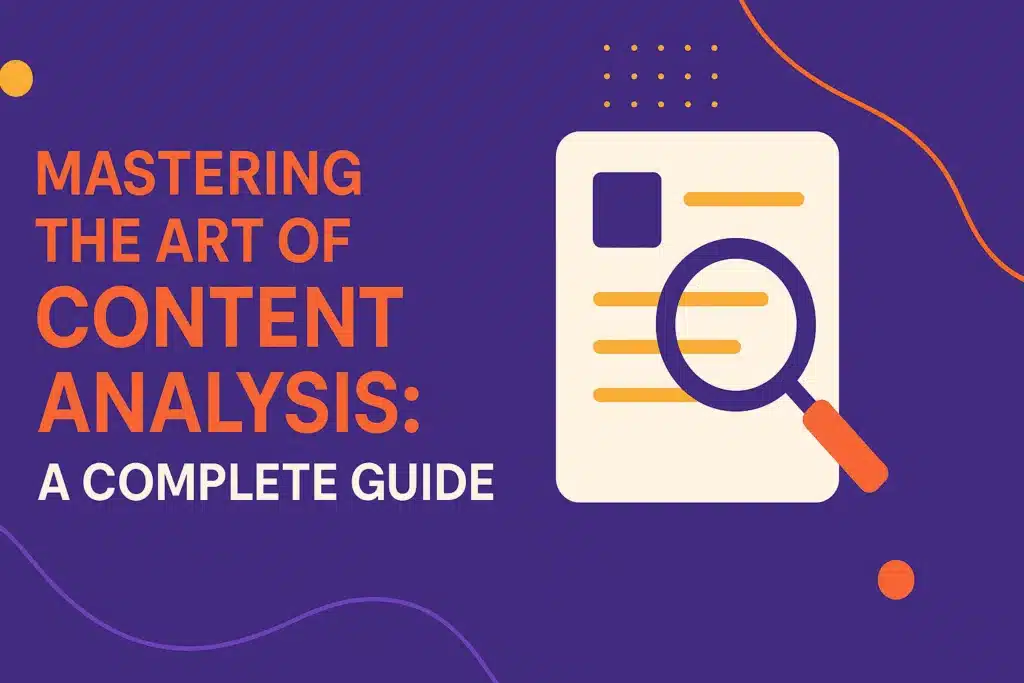What is Content Analysis?
Content analysis is a systematic approach that examines, interprets, and quantifies written, visual, or spoken material. It counts themes, reveals patterns, and draws meaningful insights from large streams of data. This approach not only compares trends and measures audience behavior but also refines strategies. Researchers frequently use it to discover hidden messages and validate theory-based frameworks. Overall, content analysis is a very useful tool in evaluating both qualitative and quantitative facets of various content forms effectively.
How to Measure Content Performance
Track core engagement metrics like clicks and time
Tracking key engagement metrics is essential for knowing how users connect with content. It records data such as page clicks, time spent on each page, and user movement paths. These figures help identify which elements appeal to audiences while also revealing moments when readers lose interest. By monitoring these signs, marketers can adjust their content strategies, improve user experience, and clearly demonstrate the real worth of their work to increase overall digital performance results consistently.
Use behavior tracking tools for deeper insights
Using behavior tracking tools provides a more detailed view into user actions beyond mere clicks. These tools capture detailed user movements, hover patterns, and scroll behaviors to reveal subtle engagement signals that basic metrics might overlook. By studying this data, marketers find user intent, improve content layout, and adjust interaction points to drive higher satisfaction and conversion rates. This method improves insights and informs strategic content improvement effectively for success.
Compare organic vs. paid content effectiveness
Studying organic versus paid content performance creates standards. This process reviews metrics such as impressions, clicks, and conversion rates to evaluate campaign strategies fairly. It reveals which approaches boost engagement and ROI. Such comparisons help rank content investments and improve tactics, helping marketers improve both organic reach and paid influence. This method enables better decisions, as noted by Hootsuite (Hootsuite). Ultimately, data leads to smarter, improved content investments for long-term growth.
Step by Step Content Evaluation Process
Set specific goals for your content efforts
Setting up clear content goals provides direction for measuring success. When you set specific objectives—ranging from increased page views and better user engagement to higher conversion rates—it focuses marketing efforts on wanted results. Targeting exact metrics offers a reliable benchmark for tracking progress. These goals guide content creation, assessment, and improvements while matching overall business aims. In the end, clear targets ensure that marketing initiatives are regularly measured and refined, leading to improved campaigns and a clear return on investment.
Audit content pieces with a performance checklist
Reviewing content pieces with a performance checklist helps find areas that need to get better. This process involves checking SEO standards, ease of reading, and engagement metrics. A complete review shows content gaps, old info, and technical issues. Marketers then decide whether to maintain, update, or remove content accordingly. Using a detailed checklist creates regularity and aligns with performance goals, ultimately enhancing search visibility and user experience to drive checkable, important changes in outcomes.
Sort findings based on performance categories
Grouping findings based on performance levels sorts insights into useful items. Grouping content segments into high, medium, and low performance helps rank necessary revisions. This method simplifies decision-making by highlighting which pages need immediate attention and which ones work well. Such organization supports targeted changes and guides future content planning, ensuring ongoing improvement of online content for consistent, long-term audience engagement.
Different Types of Content Assessment Methods
Quantitative content techniques for data-driven results
Numerical techniques use numerical data to fairly assess content performance. This method involves counting word counts, studying view counts, and tracking various engagement metrics. Using statistical tools, it shows trends and patterns that drive digital results. By providing hard numbers, these techniques enable marketers to compare content pieces accurately, make informed decisions, and refine strategies for improved outcomes. Using quantitative analysis creates a basis for clearly measurable growth.
Qualitative content reviews for tone and structure
Descriptive reviews look at the tone, style, and structure of content. They check how well the content communicates and resonates with the target audience. This method uses a personal assessment of clarity, flow, and voice in both text and visuals. Such reviews uncover better areas that numerical metrics might overlook and help suggest improvements to make content more engaging and reader-friendly, ultimately improving overall clarity.
Hybrid assessments combining metrics with user feedback
Hybrid assessments combine quantitative metrics with qualitative user feedback to provide a complete content evaluation. This approach records hard data while considering audience perspectives and personal experiences. It joins numeric trends with individual reactions, creating a more complete picture of performance. These methods uncover insights that each approach alone might miss and inform changes, resulting in content that meets measurable targets and connects with readers for a better impact.
Conclusion
A thorough content analysis provides insights essential for improving digital strategies. By understanding engagement metrics, setting clear goals, and systematically reviewing content, marketers get a better understanding of what resonates and what requires improvement. Both quantitative and qualitative assessments play important roles in enhancing content effectiveness. Regular audits and evaluations drive smarter decisions, align efforts with business objectives, and foster growth in audience engagement. In today’s online marketplace, learning these techniques helps that content remains effective and resonates with its target audience. Organizations that invest in content analysis enjoy improved performance, increased ROI, and lasting audience loyalty.



